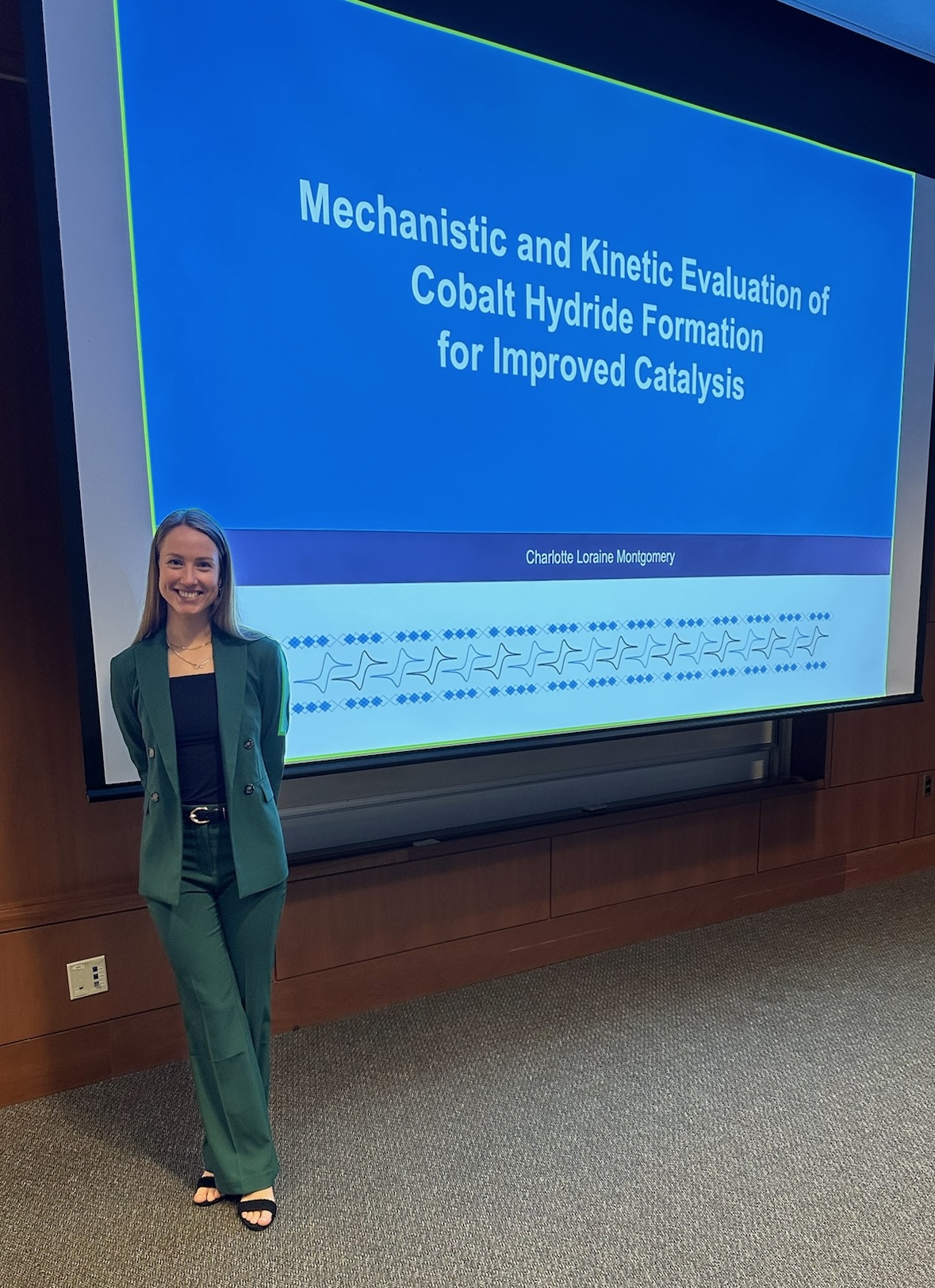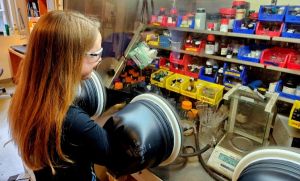Charlotte Montgomery’s Molecular Design Tweaks Paving the Way to Cleaner Energy

Charlotte Montgomery's research, recently published in Inorganic Chemistry as part of a special issue on “Proton-Coupled Electron Transfer in Coordination Chemistry,” tackles a highly specific, but critical, question: how does tweaking tiny chemical features on a molecule affect its ability to form a crucial intermediate called a metal hydride?
June 12, 2025 I By Dave DeFusco
When Charlotte Montgomery arrived at the University of North Carolina at Chapel Hill to pursue her Ph.D. in chemistry, she didn’t plan on helping solve one of the most complicated problems in clean energy. But she loved puzzles and in the world of chemistry, few puzzles are trickier, or more important, than how to efficiently convert electricity into fuel.
Her research, “Impact of Pendant Amine Basicity on Electrochemically-Promoted Cobalt Hydride Formation: Kinetic and Mechanistic Analysis,” recently published in Inorganic Chemistry as part of a special issue on “Proton-Coupled Electron Transfer in Coordination Chemistry,” tackles a highly specific, but critical, question: how does tweaking tiny chemical features on a molecule affect its ability to form a crucial intermediate called a metal hydride? And how can that information be used to make better catalysts—the molecules that speed up chemical reactions—for clean fuel production?
At first glance, this might seem like an obscure detail of academic chemistry, but the impact could be massive. Efficient catalysts that help turn carbon dioxide into fuel using renewable electricity are one of the holy grails of climate technology. They could help us store solar or wind power as usable liquid fuel—essentially bottling sunshine for when we need it.
“Catalysts have a lot of room for improvement,” said Montgomery, “but you don’t know how to fix something until you know why it’s broken. I like studying the nitty-gritty details—figuring out where the bottlenecks are and what we can do to open them up.”
At the heart of Montgomery’s work is a metal called cobalt. Specifically, cobalt complexes—molecules where a cobalt atom sits at the center, surrounded by ring-like structures called ligands. These complexes can form what’s known as a cobalt hydride, where a hydrogen atom is attached to the metal.

That step, forming a metal hydride, is key in converting carbon dioxide into energy-rich products like formate or carbon monoxide—building blocks for synthetic fuels. But exactly how the hydrogen gets to the cobalt—through what sequence of chemical steps—isn’t always straightforward.
To investigate, Montgomery focused on what’s called a “pendant amine”—a nitrogen-containing arm hanging off the side of the molecule that can help transfer protons, a key part of hydrogen atoms, to the metal. Importantly, not all pendant amines are created equal. Some are more basic—willing to grab protons—and some are less. By changing the nature of this pendant amine—making it more or less basic—Montgomery could essentially rewire the mechanism of hydride formation.
“This project was really inspired by wanting to understand how those changes in basicity change the pathway of the reaction,” she said. “Do they make it faster? Do they make it more efficient? And how can we use that to make better catalysts?”
Montgomery tested three variations of the pendant amine: benzyl (most basic), phenyl (least basic) and methoxyphenyl (somewhere in between). It was more than just a mix-and-match exercise. Each change altered the thermodynamics—how much energy was needed or released—and the kinetics—how fast things happened.
“We saw a real marriage between thermodynamics and kinetics,” said Montgomery. “By changing the basicity, we changed the speed and efficiency of the reaction. That’s huge if you’re trying to make fuels fast and cleanly.”
Of the three, the benzyl version surprised her the most. It turned out to be the most reactive, allowing access to a variety of reaction pathways. That lucky choice—starting with benzyl—set the tone for her whole dissertation.
“I sometimes think about how my dissertation would’ve been different if I’d started with the phenyl version instead,” she said. “That one wasn’t basic enough to even access some of the pathways. The whole project might not have happened.”
Montgomery didn’t just rely on trial and error. She used a range of sophisticated tools to figure out exactly where the chemical action was happening. By designing a series of experiments that used acids of varying strength, she was able to track changes in the reaction’s behavior, like a detective watching for subtle clues. She then backed up her experimental findings with computer simulations and theoretical models, which confirmed that the proton—the hydrogen—was initially attaching not to the cobalt metal itself, but to the nitrogen on the pendant amine.
“That tells us something really important,” she said. “It shows how critical the ligand—the part of the molecule surrounding the metal—is in controlling the reaction. That’s a huge insight for designing better catalysts.”
One of the most exciting outcomes of her study is the realization that by tweaking the pendant amine, chemists can control which product is formed from carbon dioxide. If the pendant amine is very basic and reactive, it helps form a cobalt hydride, which in turn makes formate—a type of liquid fuel. But if the amine is less basic, formate production can become less favorable. In different systems without a pendant amine site, hydride formation may be shut off entirely and a different reaction happens, producing carbon monoxide, which can be converted into methanol or ethanol.
That ability to steer the reaction one way or another is known as selectivity. It’s a big deal in chemistry, because it means you can produce the fuel you want with fewer unwanted byproducts. For Montgomery’s mentor, Dr. Jillian Dempsey, Bowman and Gordon Gray Distinguished Term Professor, the study represents more than just a successful dissertation.
“Charlotte’s work provides guiding principles for how subtle changes in molecular design can completely reshape a catalyst’s reactivity,” said Dempsey. “Fundamental science like this provide critical foundations for future sustainable energy technologies.”
Dempsey said Charlotte’s discoveries offer exactly the kind of deep insight scientists need to design better, faster and more efficient catalysts for tomorrow’s energy technologies.
“When developing next-generation catalysts, the types of catalyst structure-reactivity details Charlotte revealed can provide an essential blueprint for what sort of design changes to make to enhance performance,” said Dempsey. “This sort of critical design puts us on an accelerated path toward catalysts that operate with the required metrics for next-generation technologies.”
After finishing her Ph.D., Montgomery accepted a position at Exponent, a scientific and engineering consulting firm, where she will apply her chemistry background to real-world legal and business challenges.
“It’s kind of a full-circle moment,” she said. “I did an internship at Estée Lauder as an undergrad and another at a startup, AIRCO, working on sustainable aviation fuel during graduate school. Now at Exponent, I’ll be working on cases involving fuels, lubricants and cosmetics.”
She first connected with the firm during Industry InSight, a professional development event she helped organize at UNC. “I’ve always loved problem-solving and communicating science clearly,” she said. “Exponent lets me do both, while still staying connected to chemistry.”

